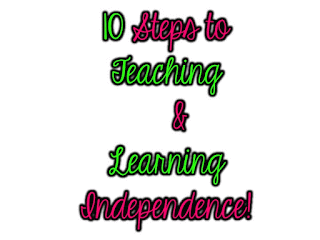Thanks again to Brenda at Primary Inspired for hosting this Book Study.
I'm talking to you about my favorite part of Daily 5.
INDEPENDENCE!
I know you're probably saying "I work with children. Independence isn't part of their vocabulary..." Rest assured friends... students can and will be able to work independently. You just need to be diligent and help them get there. How you ask?
Follow the 10 steps outlined by the sisters
whenever you're introducing the components of daily 5.
Step 1:
Identify what needs to be taught!
Set an objective for yourself and the students. It's so important for kids to know what they're learning and the expectations.
Step 2:
Set a purpose and create a sense of
urgency!
I call this the 'BUT WHY??!' Step. It's the step that helps create the feeling with the students that every moment is spent learning and practicing. Speaking from experience...the kids will truly value their time spent reading and learning. They won't let anything get in their way.
Step 3:
Record desired behaviors on I Chart
As a teacher I know how important it is to use visuals including anchor charts so when I read this step I actually did a little dance! I've drawn up this kind of anchor chart during my first few years of teaching.
What you can do after making this is have the students practice, take pictures, and place them on the anchor chart. It helps keep students accountable.
Step 4:
Model most-desirable behaviors
Because this is something you'll be doing for the entire year, it's important to show students the correct way from the beginning. It also means more when you teach expectations using a positive and specific approach instead of the No's and Don'ts. It becomes a part of your culture.
Step 5:
Model least-desirable behaviors, then most-desirable
After students know your expectations for the behavior it's ok to have them identify inappropriate behavior, but it should be specifically centered around the affect your behavior has on reading. For example when you model off task student behavior it's important to talk about whether it's making you a better reader or not. The second part of this step is actually repeating step 4. Always go back to the correct modeled behavior so students remember the expectations.
Step 6:
Place students around the room
It's easy to think that students may be able to place themselves around the room, but let's be real... sometimes teaching can be like herding cats. It's better to place students in appropriate spots first. If you do that they can rely on these as base places they know they will be successful in.
Step 7
Practice and build stamina
This step is kind of self explanatory. Allow the students to practice. Gauge and record their stamina! The sister recommend several different ways but I love having my students recording their own data.
Check out this example from Mel D and her Seusstastic Classroom Inspirations.
Step 8:
Stay out of the way...
Easier said than done I know.
I have to restrain myself from doing what I know to do... weave in and out between students, check in, praising for correct behavior, etc.
But it's so important for you to LET THE STUDENTS PRACTICE ON THEIR OWN!
If you don't the students will struggle with working without your praise and check ins therefore eating up the time you could be using with individual or small groups.
NOW...
That doesn't mean you get to kick off those sensible shoes and surf Pinterest.
*ahem administrators take note*
During this time you can be recording the students stamina. You should be aware of the movement of the students around the room. Running out of stamina behavior looks like students getting drinks, talking to one another, etc.
Step 9:
Use a quiet signal to bring students back to the gathering space.
Quiet signals are exactly what it sounds like. They're meant to help students associate that noise with coming back together as a group. Kinda like Pavlov dogs if you think about it. Something calm is what the sisters recommend... I've used quiet instrumental songs or a rainstick.
Step 10:
Conduct a group check-in; Ask, "How did it go?"
Conducting a group check in is really for the students. It's a chance for the students to self reflect their stamina or behavior. Ask students specific questions and let them identify strength and areas of improvements.
I personally love using the 4 finger self assessment.
1- I struggled focusing, and really need to practice this behavior.
2- I stayed focused but still could use practice.
3- I am focused most of the time.
4- I have mastered this and can help others with this.





No comments:
Post a Comment